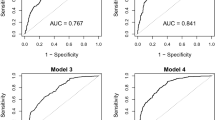Abstract
To investigate the significance of waist circumference (WC), body mass index (BMI) and hyperinsulinaemia A (HIns) in evaluating metabolic syndrome (MS). Clinical data from middle-aged and senile individuals (middle-senile group) who received glucose tolerance test after diabetes mellitus screening and a group of subjects who received annual oral glucose tolerance test (OGTT) for diabetes mellitus screening (adult group) were collected. Data were collected by use of special messengers, input into a computer data base and analyzed using SAS 5.0 software by expert staff. Abnormal WC and BMI were determined according to International Diabetes Federation (IDF) and Chinese Diabetes Society (CDS) criteria. HIns was ascertained if fasting insulin (FIns) ⩾ 15 mU/L, and/or 2-hour insulin after a glucose challenge was (2hPIns) ⩾ 80 mU/L. Abnormalities in WC, BMI and HIns were all found to be risk factors for abnormal glucose metabolism, hypertension and dyslipidemia. In the middle-senile group, the abnormality rate of WC and HIns as well as the overall insulin level were significantly higher than those in the adult group. The abnormality rate of BMI was higher in the adult group, and HIns was mostly seen in impaired glucose test (IGT) and normal glucose test (NGT). The concordance rate of WC and BMI diagnostic criteria for evaluating obesity in the middle-senile and adult groups were 77.5% and 74.3%, respectively. When only the WC criterion was used for evaluating the existence of insulin resistance, there was a 28.2%missed diagnosis rate for MS patients. WC, BMI and HIns were all risk factors for abnormal glucose metabolism, hypertension and dyslipidemia. There was differing prevalence in the different populations. The combination of WC, BMI and HIns might be more helpful in identifying MS at early stage.
Similar content being viewed by others
References
Reaven G M. Role of insulin resistance in human disease. Diabetes, 1988, 37: 1595–1599
Rennert N J, Charney P. Preventing cardiovascular disease in diabetes and glucose intolerance: evidence and implications for care. Prim-Care, 2003, 30(3): 569–574
Mainous AG3rd, Everett C J, Liszka H, King DE, Egan BM. Prehypertension and mortality in a nationally representative cohort. Am J Cardiol, 2004, 94(12):1496–1500
Csernus K, Lanyi E, Erhardt E, Molnar D. Effect of childhood obesity and obesity-related cardiovascular risk factors on glomerular and tubular protein excretion. Eur J Pediatr, 2005, 164(1): 44–49
International Diabetes Federation: The IDF consensus worldwide definition of the metabolic syndrome. http://www.idf.org/webdata/docs/Metabolic _syndrome _definition
World Health Organization. Definition, diagnosis and classification of diabetes mellitus and its complications: report of a WHO consultation. Part 1. Diagnosis and classification of diabetes mellitus. Geneva: World health Organization, 1999
Co-operation group of diabetes branch of Chinese Medical Association for study of metabolic syndrome. Suggestion about metabolic syndrome by diabetes branch of Chinese Medical Association. Zhongguo Tangniaobing Zazhi, 2004, 12(3): 156–159 (in Chinese)
Hirschler V, Roque M I, Calcagno M L, Gonzalez C, Aranda C. Maternal waist circumference and the prediction of children’s metabolic syndrome. Arch Pediatr Adolesc Med, 2007, 161(12): 1205–1210
Hirschler V, Maccallini G, Calcagno M, Aranda C, Jadzinsky M. Waist circumference identifies primary school children with metabolic syndrome abnormalities. Diabetes Technol Ther, 2007, 9(2): 149–157
Qiu DY, Hu Y, Lu J, Cai Y Y, Wu L, Zhu J Y. Body mass index, waist-to-hip ratio and waist circumference are indicators for impaired glucose tolerance/type 2 diabetes mellitus in the elderly. Di’er Junyi Daxue Xuebao, 2006, 27(1): 58–61 (in Chinese)
Xie X D, Zhuang X Y. Detection of metabolic syndrome in general health examination. Riben Yixue Jinzhan, 2005, 26(5): 218–221 (in Chinese)
Arai H, Yamamoto A, Matsuzawa Y, Saito Y, Yamada N, Oikawa S, Mabuchi H, Teramoto T, Sasaki J, Nakaya N, Itakura H, Ishikawa Y, Ouchi Y, Horibe H, Shirahashi N, Kita T. Prevalence of Metabolic Syndrome in the General Japanese Population in 2000. J Atheroscler Thromb, 2006, 13(4): 202–208
Cheng Y, Pan C Y, Tian H, Lu J M. A pilot evaluation of the diagnostic value of body mass index in elderly men with metabolic syndrome. Zhonghua Nei Ke Za Zhi, 2006, 45(2):100–103 (in Chinese)
Tian H, Yao C. Investigation on the prevalence of obesity in adult of Beijing city. Zhonghua Liu Xing Bing Xue Za Zhi, 1993, 14(S): 307–309 (in Chinese)
Mei B Y, Chen J Y, Yang W S, Chi Y C, Liou Y J, Lin C C, Wang Y C, Lin C Y, Su T P, Chou P. Adiponectin as a potential biomarker for the metabolic syndrome in Chinese patients taking clozapine for schizophrenia. J Clin Psychiatry, 2007, 68(12): 1834–1839
Author information
Authors and Affiliations
Corresponding author
Additional information
__________
Translated from Medical Journal of Chinese People’s Liberation Army, 2007, 32(10): 1001–1004 [译自: 解放军医学杂志]
Rights and permissions
About this article
Cite this article
Tian, H., Fang, F., Shao, Y. et al. Value of waist circumference, body mass index and hyperinsulinaemia in identifying metabolic syndrome. Front. Med. China 2, 400–405 (2008). https://doi.org/10.1007/s11684-008-0077-z
Published:
Issue Date:
DOI: https://doi.org/10.1007/s11684-008-0077-z




